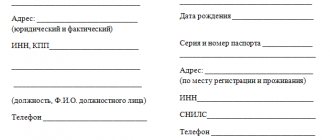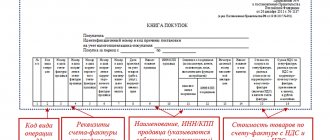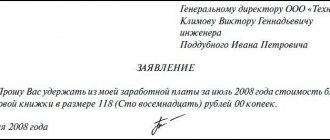The list of details for inclusion in the check is presented in Law No. 54-FZ. Initially, 7 mandatory details were identified. Later amendments were made, and now there are 24 such details.
In addition, as of January 1, 2020, version FDF 1.0 has lost legal force and its use is unacceptable. It is necessary to use CCP with format 1.05 and 1.1. They include a larger amount of data, so sometimes there is confusion about how to correctly complete a particular operation. Today we will talk about the key details and the features of their use.
We will solve any problems with your equipment!
Leave a request and get a consultation.
Calculation method in a cash receipt: what is it, when is it used
The “payment method attribute” attribute indicates which payment scheme was used when concluding the transaction. The list of its values was published in the Order of the Federal Tax Service No. ММВ-7-20/ [email protected] Subsequently, the document was changed by Order No. ММВ-7-20/ [email protected] After the update, the list looks like this:
Let's look at a few examples of how to correctly set the payment method attribute in a cash receipt.
- Setting up an online cash register
2 reviews
1 000 ₽
1000
https://online-kassa.ru/kupit/nastrojka-onlajn-kassy/
OrderMore detailsIn stock
- Cash register repair
990 ₽
990
https://online-kassa.ru/kupit/remont-kassovyh-apparatov/
OrderMore detailsIn stock
- Technical support
1 review
3 900 ₽
3900
https://online-kassa.ru/kupit/tehnicheskoe-soprovozhdenie/
OrderMore detailsIn stock
Sales with prepayment
The buyer purchases furniture and transfers the entire amount in advance (before delivery). The check is issued twice:
- When an advance payment is received – “Advance payment 100%”.
- Upon delivery of the goods to the customer - “Full payment”.
Sale with prepayment in installments
The client purchases furniture and pays part of its cost immediately, and part - after the furniture has been delivered to his home. The receipt is printed twice:
- When paying part of the cost - “Advance payment” for the amount paid.
- When the cabinet is handed over to the buyer - “Full payment” for the amount of the additional payment.
If an advance is made
If an advance is made against future purchases, and it is unknown which goods and in what volume will subsequently be ordered, then we use the “Advance” payment attribute in the cash register receipt. For example, when it comes to gift cards.
Let's say a customer buys a gift certificate. After some time, another client uses this certificate when purchasing goods - he pays part of the amount in cash, and the rest - from the certificate. We punch it twice:
- When selling a card - “Advance”.
- When registering sales – “Full payment”.
1. Ask our specialist a question at the end of the article. 2. Get detailed advice and a full description of the nuances! 3. Or find a ready-made answer in the comments of our readers.
Installment plan without down payment
An individual entrepreneur buys office equipment with deferred payment. The money is transferred 2 weeks after delivery. We format it as follows:
- When goods are transferred – “Transfer on credit”.
- When all funds have been received – “Loan payment”.
Installments and down payment
If the buyer contributes the money partially, and intends to repay the debt over several months, making monthly payments, then it will be like this:
- When the goods are transferred to the client - o.
- Every month, each time you pay a share of the debt, “Loan payment” is indicated.
For cash registers working with FFD 1.1 and 1.05, the “Settlement method attribute” in the cash receipt is required.
You may be interested in: How an advance payment is formed at online cash registers
How to cash out?
Many people get confused when receiving a document and do not know how to turn a “piece of paper” into money. To cash a check, just contact your banking institution. In this case, the algorithm of actions may change depending on the currency of receipt - rubles or money of another country.
To cash a check in rubles, you should proceed as follows:
- Come to the bank with your passport.
- Submit an application for collection services.
- Submit a correctly executed payment document.
- Receive a copy of the application (the credit institution keeps the original).
- Make a transfer signature (issued directly at the bank).
- Pay a commission for the service (most often 2-5% of the amount on the check).
- Receive payment (done after full verification).
The timing of crediting depends on the location of the credit institution of the party that issued the payment document.
How to cash a check in foreign currency? The algorithm is like this:
- Go to a financial institution and fill out an application.
- Open a foreign currency account (a prerequisite for cashing checks).
- Pay a commission for the service.
- Execute a transfer signature (in the presence of a bank employee).
- Submit a document that would confirm the legality of receiving funds (if the amount is above $5,000). If the employer transfers the money, he, as a rule, issues this paper.
- Receive funds into your account after confirmation of the legality of the transaction by the bank.
Average time for funds to be credited (from the date of application - 50-60 days).
Correction check – which calculation feature to choose?
Such a check is generated if a payment was previously made without a cash register or in violation of the law. The cashier or the owner of the cash register can himself detect and eliminate the error by making a correction, or do this according to an order received from the Federal Tax Service.
On cash register systems with different FFDs, the correction checks are different - different calculation signs are indicated (an explanation is given in the letter of the Federal Tax Service No. ED-4-20 / [email protected] ).
If cash register was not used when making payments:
- For FFD 1.05 – when receiving funds, set “Income”, when paying out – “Expense”.
- For FFD 1.1 - “Receipt” and “Expense” we indicate similarly to FFD 1.05, if a purchase is being returned - we indicate “Return of Income”, if the client returned the funds issued to him earlier - “Return of Expense”. If there is an error in the check (for example, VAT is entered incorrectly), the same for FFD 1.05 and FDF 1.1: create a “Receipt Return” check, identical to the incorrect one, and generate a “Receipt” check.
It is not necessary to correct the error on the device where it was made, or which has not been used before. The legislation of the Russian Federation does not oblige this. An organization or individual entrepreneur can generate a correction document on any cash register they own, if it is registered and operates in compliance with all standards.
Types of bank checks
According to the form of financial circulation:
| Peculiarities | Cash | Calculated |
| Receipt form | Cash | Cashless |
| Purposes of receiving | Salary, travel allowances, food purchases | For goods and services, as a rule, in counterparty payments |
| Transfer moment | There is a time gap between receiving funds and making the intended expenditure | Transferred by the payer to the recipient at the time the transaction is performed |
By type of statement:
| View | Recipient |
| Nominal | Certain person |
| Bearer | The person who issued the document |
| Warrant | The recipient or endorsee to whom the endorser or drawer transfers the check as the new owner through the endorsement procedure |
| Crossed | On the front side of the document there are two parallel lines crossed out. A check can only be marked with one crossing |
| With general crossing | Between the lines is empty, there may be a “bank” label. Paid by the paying bank only to another bank or to its own client |
| With special crossing | The name of the payer is entered between the lines. Paid only by the specified bank |
By validity period:
| Jurisdiction where the check is issued | Issuance period in days |
| Russia | 10 |
| CIS | 20 |
| Other | 70 |
Differences from bonds, bills and loan agreements:
| Characteristics of papers | Check | Bond | Bill of exchange | Loan agreement |
| Kind/type | Central Bank/payment document | Central Bank/debt paper | Central Bank/debt paper | Is not a Central Bank/document |
| Release | Unit | Emission | Single/emission - small batches | Unit |
| Form | Documentary | Documentary/non-documentary | Documentary | Documentary |
| State registration | Not registered | Mandatory | Not required | Not registered |
| Paper calculations | Allowed | Not allowed | Can be used as a means of payment | Not allowed |
| Transfer of rights | Through endorsement | Sale under purchase and sale agreement | Transferred by order of its owner | Only assignment is allowed, i.e. transfer of rights specified in the agreement |
Indicator of the subject of payment in a cash receipt: what does it mean?
This designation appeared starting with FFD 1.05. Used to indicate goods, payments, etc.
Main categories:
- Goods (on which excise duty is not charged) – “GOOD” or “T”.
- Goods that are subject to excise taxation are “EXCISABLE GOODS” or “AT”.
- Payment/payment (bonuses, advance, fines, various types of remuneration, deposit, etc.) – “PAYMENT” or “P”, “PAYMENT” or “B”.
- or "U".
- Work – “JOB” or “R”.
A complete list of characteristics of the subject of payment in a cash receipt is given in Order No. ММВ-7-20/ [email protected]
You may be interested in: Sample of an online cash register receipt - what it looks like, requirements and details
Sample filling
The form must be filled out very carefully and accurately; a check is a strict reporting form and does not allow any errors or corrections. If an error was made during the filling process, then it becomes invalid, and the form is crossed out and the inscription “cancelled” is written. There is no need to tear out the damaged form from the book.
A blank check from a checkbook consists of a counterfoil and a tear-off part. You need to fill out both parts, after which the right part is torn off along the cutting line and transferred to the bank to receive money, the left part (the spine) remains in the checkbook.
There are certain rules for filling out a checkbook that you need to follow.
Filling rules:
- the check must reflect the amount to be paid to the bearer, in figures and in words. The amount in words must be written from the beginning of the line, indicate the amount itself and the currency in which you want to pay cash, the empty space remaining on the line is crossed out;
- in addition, the check must correctly indicate the details of the owner of the book (that is, the drawer) and the bank details;
- the date of filling out the form must also be indicated (the check is valid for 10 days, after which it becomes invalid) and the place of issue (local area);
- in the “to” line the full name of the person to whom the check was issued and to whom the bank should pay the amount must be indicated;
- the check must contain an order to give the bearer the specified amount of money;
- The signatures of authorized persons and the seal of the drawer must be present.
- the recipient of the money indicated on the check must put his signature as a sign that he has received the document;
- expenditure goals are indicated in accordance with what the amount is planned to be spent on;
- All entries are made manually using a blue or black pen.
Fiscal sign of a cash receipt (document): how it is formed, what to do in case of an error
It is briefly designated FPD and is a digital code that defines the characteristics of the calculation performed when sending OFD data and to the tax office.
Generated by the fiscal drive based on the following information specified during registration:
- User's TIN;
- TIN OFD with which the agreement was concluded;
- cash register numbers – registration and factory;
- registration dates indicating the exact time;
- serial number of the check.
If the tax service has refused registration because the fiscal attribute of the cash receipt is incorrect, check whether the above items match the registration report and the receipt itself.
Registration may also be denied if the individual entrepreneur or organization has not completed the registration procedures within 24 hours of receiving the registration number.
Common mistakes made during registration:
- The time and date settings at the checkout are incorrect (for example, 2000).
- On the diagnostic receipt, the serial number of the device differs from the number that was indicated in the registration application.
- Inaccuracies in the registration number, user INN and OFD INN.
What to do:
Be careful when entering all data. It is impossible to correct them once they have already been added to, and the fiscal drive will have to be changed. It is impossible to close it in normal mode - you need to perform an emergency closing.
https://youtu.be/1wPrXGwx9cQ
Validity
The deadline for presenting checks for payment is not established by law. However, taking into account that the procedure and conditions for the use of checks in payment transactions are regulated, in addition to the Civil Code, by other laws and banking rules established in accordance with them, it can be noted that on the territory of the Russian Federation a check is payable within:
- 10 days if he is discharged in Russia;
- 20 days if issued on the territory of the CIS member states;
- 70 days if issued in the territory of any other state.
Fines
An unclogged or incorrectly drawn up check are the reasons that lead to a fine being imposed on the individual entrepreneur. The Code of the Russian Federation on Administrative Offences, Article 14.5, establishes punishment for such violations. The fine amounts range from 1.5 to 2 thousand rubles for individual entrepreneurs.
It is the issuance of fiscal documents that confirms the purchase and sale transaction. The cash receipt must be printed exclusively by the cash register. Other methods of preparing this fiscal document are not possible.
The only exceptions are those individual entrepreneurs who are permitted by law to use strict reporting forms instead of a cash receipt. In such cases, there is no penalty for failure to issue a check. But this document is used mainly by those individual entrepreneurs who provide services without selling goods.
The main reasons for imposing a fine in the process of using cash registers and issuing cash receipts are:
- non-use of cash registers;
- use of control equipment that is not registered with the tax authorities;
- use of cash register, which is not included in the State Register;
- using faulty equipment that prints incomplete receipts;
- use of a cash register without a seal;
- issuing checks with amounts different from those actually paid.
The fine is imposed by the fiscal authorities after violations are detected.
Advantages and disadvantages
Compared to corporate cards, a checkbook has only one drawback: withdrawing funds takes a lot of time: filling out, traveling to a credit institution. But there are situations when it reduces the actual time it takes to cash a check.
Using a plastic card involves opening a special account, which is replenished by executing payment orders. Using the card, it is possible to receive only the amount that was previously deposited on it. And if you need to pay urgently in cash to the supplier and the funds transferred are not enough? The movement of money between accounts will take one day, and with a check it is possible to satisfy them within an hour.
Sending money for a card account “cools” it and limits the working capital of the enterprise. Quickly use the funds transferred to the card to implement non-cash payments, which they will not be, since it will take time to return them. And checks on financial transfers are not required; they are designed to work through a current account.
Withdrawing cash by check is more profitable as it has less interest charged by banks on this transaction. There is a fixed fee for using the card, regardless of the purpose for which the funds received will be spent. Usually this is 2-4%. In checks, the money withdrawn is determined by the bank interest rate dependent on it. For example, for salary it is 0.5.
History of appearance and development
Prototypes of checks have been mentioned since the 6th century BC. e. These were clay tablets from the banks of Babylon, Persia, India, and ancient Rome. But today it has not been established which nation was the first to use this type of paper document.
Some historians are inclined to consider the ancestors of checks to be the French Knights Templar, who were trusted representatives of the royal treasury and were involved in collecting tribute. Pilgrims handed over property to the Templar bankers for safekeeping and received exchange certificates. There are scientists who attribute the knights of England to the discoverers of checks, since the securities received from this country spread throughout Europe.
From an etymological point of view, both theories are relevant.
- On the one hand, the term “check” may come from the English. to checker, translated - to place in a checkerboard pattern. English banks carried out calculations first on a graphed board, then on a table covered with cloth with a checkered pattern. From the 12th century to the end of the 19th century, the English State Treasury was called the Chamber of the Chessboard and was the highest body of financial management.
- On the other hand, the word “check” can also come from the French chèque, which literally translates as “check.”
However, the first check is considered to be a document executed by the Englishman Nicholas Vanaker (Nicholas van Acker) in 1660 for the amount of 400 pounds. This paper has survived to this day. The first bank check printed in a printing house is believed to be a document issued by the Hoare Bank of London in 1763, but they became especially popular in the 19th and 20th centuries. Since the 60s of the last century, checks have been encoded with MICR magnetic ink with paper number codes, account and bank information. Their owners gained the opportunity to receive money from any bank, and the MICR technology itself is still in demand.
Options for changing and restoring a cash register receipt
If necessary or at the request of the consumer of goods or services, the entrepreneur can restore or correct the originally printed fiscal document. There are several ways to do this.
Correction check
Applies if, while accepting money and before printing the document, there is a power outage in the store. Then the amount accepted from the consumer is punched later when such an opportunity arises. This fiscal document contains the same information as in a regular document, with the exception of the fiscal attribute. In this case, it is not necessary to indicate the list of purchased goods, as well as the consumer’s phone number and e-mail. The total payment amount accepted must be accurate and match the amount the buyer deposited at the cash register.
Note! You can generate a correction check on any cash register, and not just on the one where you planned to make the payment.
Refund check
If an error is made in a fiscal document, the cashier can generate a refund check.
It indicates such a fiscal sign of an incorrectly stamped document as “additional details”. The “counter submission” option is selected as the payment method. This means that the buyer's money was not returned.
Receipt for advance payments
If the buyer has made a 100% prepayment, then before the goods are transferred to him, he must enter a document with the fiscal sign “receipt” and with the sign of the payment method “100% prepayment.”
After receiving the pre-paid goods, a second check is issued with the fiscal sign for the buyer “receipt” and the sign of the payment method “transfer on credit”.
Restoring a check from the Federal Fund
If you need the cash register to print out the main and duplicate fiscal document at any time, you should install a special paid application “Copy of Receipt” in your OFD personal account. If desired, the cashier will be able to print the original and a duplicate or display any necessary copy for the previous period.










